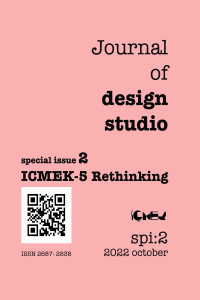A Case Study on Online Design Workshop Experience: Gamification and Space
A Case Study on Online Design Workshop Experience: Gamification and Space
Design schools consist of three main axes; courses that provide knowledge in various fields of design, studio courses and internships. Besides, the indisputable fact is the importance of design competitions and informal workshops that feed the designer candidate to gain experience in different fields of the discipline. In addition, another importance of informal workshops is the contribution of researchers in this field to the development of design education. The effects and potentials of Information and Communication Technologies (ICTs) are also another area of research on design education, in particular design studio courses. The use of ICTs in the field of design education has led gamification to come to the fore as an ascending concept. A series of methodologies and tools have been developed, such as gamification, as well as the different kinds of Virtual Learning Environments to ensure the motivation of students and avoid the lack of attention in online courses. In this study, an online workshop, "Gamification and Space", is investigated as a case study. The contribution of the concept of gamification to design education has been evaluated in line with the observations and experiences gained. The data was gathered from the workshop presentations held on the last day and the final manuscripts of the workshops. The collected data was analyzed by the workshop coordination team, and classifications were made regarding the aspects of the gamification used during the workshop. In addition, it is aimed to discuss the potentials of ICTs in design courses. The observations show that the use of gamified elements has the potential to enrich instructional methods, especially when we consider online education, virtual learning environments and visual collaboration tools.
Keywords:
Online workshop, Gamification Interior design education, Informel learning environment, Gamed-based learning,
___
- Alawad, A. (2021). Evaluating Online Learning Practice in the Interior Design Studio. International Journal of Art & Design Education, 40(3), 526-542.
- Aşkın, G. D. (2019). Gamification of design process in interior architecture education: Who? with whom? where? how?. In SHS Web of Conferences (Vol. 66, p. 01040). EDP Sciences.
- Behl, A., Jayawardena, N., Pereira, V., Islam, N., Giudice, M. D., & Choudrie, J. (2022). Gamification and e-learning for young learners: A systematic literature review, bibliometric analysis, and future research agenda. Technological Forecasting and Social Change, 176, 121445. https://doi.org/10.1016/j.techfore.2021.121445
- Ciravoğlu, A. (2003). “Mimari Tasarım Eğitiminde Formel ve Enformel Çalışmalar Üzerine”, Yapı Dergisi, sayı:257, s. 43-47.
- Gül, L.F., Gu, N., & Williams, A. (2008). Virtual worlds as a constructivist learning platform: evaluations of 3D virtual worlds on design teaching and learning. ITcon, Vol. 13, pg. 578-593.
- Gogu, C. V., & Kumar, J. (2021). Social Connectedness in Online versus Face-to-Face Design Education: A comparative study in India. In Design for Tomorrow, Volume 2 (pp. 407-416). Springer, Singapore.
- Kapp, K. M. (2012). The gamification of learning and instruction: Game-based methods and strategies for training and education. Pfeiffer Wiley, San Francisco.
- Kilic, S. and Arabacıoğlu, B. C. (2021). Lisans Düzeyinde Uzaktan Eğitim ile Gerçekleştirilen Çalıştay: Temel Tasarım Dersinde Örüntüye Dayalı Parametrik Model Kullanımı. Modular Journal, 4(2), 131-151.
- Koster, R. (2005). A theory of fun for game design. Scottsdale, AZ: Paraglyph Press, p. 34.
- Liu, Z. (2017). Exploring the use of virtual environment for international creative education (art & design).2017 IEEE 6th International Conference on Teaching, Assessment, and Learning for Engineering (TALE),414-419. IEEE. doi: 10.1109/TALE.2017.8252371
- Mekler, E. D., Brühlmann, F., Opwis, K., & Tuch, A. N. (2013). Disassembling gamification: the effects of points and meaning on user motivation and performance. In CHI '13 extended abstracts on human factors in computing systems. 1137-1142.
- Nah, F.FH., Zeng, Q., Telaprolu, V.R., Ayyappa, A.P., Eschenbrenner, B. (2014). Gamification of Education: A Review of Literature. In: Nah, F.FH. (eds) HCI in Business. HCIB 2014. Lecture Notes in Computer Science, vol 8527. Springer, Cham. https://doi.org/10.1007/978-3-319-07293-7_39
- Olmos, F. (2006). A training model to develop design skills in the virtual design studio. WIT Transactions on Information and Communication Technologies, 36.
- Peimani, N., & Kamalipour, H. (2021). Online Education in the Post COVID-19 Era: Students’ Perception and Learning Experience. Education Sciences, 11(10), 633.
- Roy, S., Singh, P. P., & Padun, A. (2021). Game-based learning for the awareness of Culture & Tradition: An exploratory case study on the Indigenous Naga Tribe. Design for Tomorrow, Volume 2, 293–304. https://doi.org/10.1007/978-981-16-0119-4_24
- Sadovets, O., Martynyuk, O., Orlovska, O., Lysak, H., Korol, S., & Zembytska, M. (2022). Gamification in the informal learning space of higher education (in the context of the digital transformation of education). Postmodern Openings, 13(1), 330–350. https://doi.org/10.18662/po/13.1/399
- Strauss, A., & Corbin, J. (1990). Basics of qualitative research. London: Sage publications.
- Turgut, H., & Cantürk, E. (2015). Design Workshops as a tool for informal architectural education. Open House International, 40(2), 88–95. https://doi.org/10.1108/ohi-02-2015-b0012
- Werbach, K., Hunter, D. (2012). For the Win: How Game Thinking Can Revolutionize Your Business. Wharton Digital Press, Philadelphia.
- Yürekli, İ., Yürekli, H., (2004). “Mimari Tasarım Eğitiminde Enformellik”, İTÜ Dergisi/A Mimarlık, Planlama, Tasarım, 3(1), pp. 53-62.
- Yayın Aralığı: Yılda 2 Sayı
- Başlangıç: 2019
- Yayıncı: Orhan HACIHASANOĞLU
